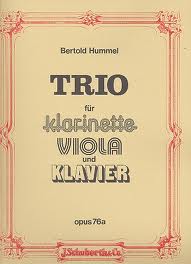Trio for Clarinet, Viola and Piano, op. 76a (1981)

I.
Introduktion
II. Allegro molto
III. Fantasia
First
performance : October 24, 1981, Karlstadt, Rathaus
Rüdiger Warnecke
/ Florian Hummel / Wendelin Treutlein
Duration: 20 Minutes
Publisher: Schott Music ED 20295 / ISMN: M-001-15000-2
| I. | II. | III. | IV. |
The
Trio for Clarinet, Viola and Piano, op. 76a is written in a concertante
style, i.e. it provides the three instruments with plenty of opportunity to show
the their capacities in terms of sonority and technical flexibility.
The
introductory 1st Movement begins with a recitative-like solo for clarinet,
this is then taken up by the viola until all 3 instruments enter into "conversation"
with each other. The form is marked by easily identifiable short motifs and 12-tone
chord structures built up from superimposed major and minor chords.
In the
Allegro molto (2nd Movement), the dominant feature are the
upwards and forwards pressing, richly syncopated melodic ideas, suipported by
pulsating basses. A peaceful middle section marks a formal division and provides
temporary relaxation of the tension. Immediately afterwards, the whirring ¾
time of the opening is heard again. The movement fades away in extreme pp.
The Fantasia (3rd Movement) is based on a 4-note series which
determines both harmonically and melodically the following series of sections
with their varied and sometimes meditative metamorphoses.
The turbulent Final
movement, which includes a very dance-like variable metrical scheme, provides
as a contrast 2 appearances of a more tranquil Fugato section. The different elements
of the movement become more and more closely connected. An effective Coda concludes
this approachable and "serene" opus.
Bertold Hummel, 21st November, 1989
Press
Nordbayerische Nachrichten, 26th January, 1982
With a solo, the clarinet leads us into the Introduction. The rhythmically forceful Allegro molto is followed by the Fantasy, full of opportunities for individual shaping and gracious towards each instrument within the ensemble. In the scherzo-like Finale, full of activity, peaceful phases recur, and each performer has the opportunity for solo passages.
Karlstadter Tageszeitung, 28th November, 1981
The climax, however, was the première of opus 76, composed specially for this trio by Bertold Hummel only a few weeks ago. In this work for clarinet, viola and piano, the composer does honour to his name. From exciting to threateningly dramatic, this music leads the ear of the listener throughout, to the Finale with all its temperament. Hummel intended that the audience should not only hear but also perceive with the ear. He wishes to reach his listener and communicate with him in the music; in this he has been successful, as the final applause showed.